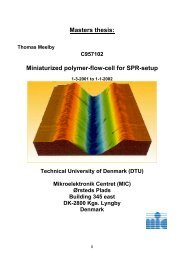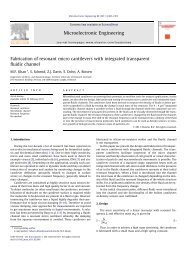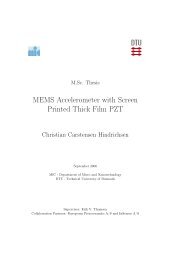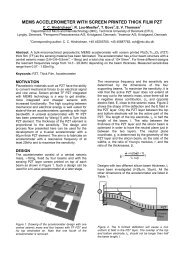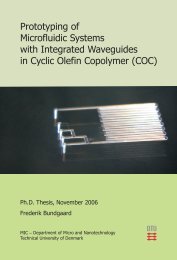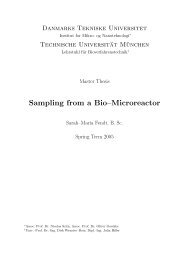Development of a Oxygen Sensor for Marine ... - DTU Nanotech
Development of a Oxygen Sensor for Marine ... - DTU Nanotech
Development of a Oxygen Sensor for Marine ... - DTU Nanotech
You also want an ePaper? Increase the reach of your titles
YUMPU automatically turns print PDFs into web optimized ePapers that Google loves.
Chapter 6<br />
Problems and Solutions<br />
In almost every project some unexpected problems appears, ranging from<br />
merely inconvenient problems such as cleanroom machinery being out <strong>of</strong><br />
work, to more actual problems, such as fabrications steps being more complicated<br />
than they appear on paper. In this chapter some <strong>of</strong> the problems<br />
encountered during the process <strong>of</strong> creating the Clark sensor will be highlighted,<br />
as well as how they were solved when possible.<br />
6.1 Wirebonding<br />
As mentioned in Chapter 5, the first, and at the time the only, choice <strong>for</strong><br />
connecting the chip to the flex print was wirebonding. Wirebonding is basically<br />
done by having a needle, with a metal (Al) thread through it, pressing<br />
down on the contact pad <strong>of</strong> the chip, and then through the use <strong>of</strong> ultrasound<br />
and vibrations attach the thread. The similar process is then repeated on<br />
the flex print, at which time the rest <strong>of</strong> the thread is snapped <strong>of</strong>f. However<br />
this would soon prove to be a lot more complicated than it sounds. For some<br />
unexplainable reasons the thread refused to per<strong>for</strong>m the second attachment,<br />
whether it was on the gold on the chip, or on the flex print. Albeit some<br />
were wirebondings were successful, they were few and there was far between<br />
them.<br />
Why this is so, remained a mystery <strong>for</strong> a while, however there was some<br />
problems with the machine at the time. However a later examination <strong>of</strong> the<br />
flex print revealed that the metal on it was tin covered copper. There<strong>for</strong> it<br />
was impossible to bond to the flex print, unless the tin was scraped <strong>of</strong>f, as<br />
49



